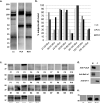Autoantibodies targeting glomerular annexin A2 identify patients with proliferative lupus nephritis
- PMID: 25824007
- PMCID: PMC4690797
- DOI: 10.1002/prca.201400175
Autoantibodies targeting glomerular annexin A2 identify patients with proliferative lupus nephritis
Abstract
Purpose: Patients with systemic lupus erythematosus (SLE) frequently develop lupus nephritis (LN), a complication frequently leading to end stage kidney disease. Immune complex deposition in the glomerulus is central to the development of LN. Using a targeted proteomic approach, we tested the hypothesis that autoantibodies targeting glomerular antigens contribute to the development of LN.
Experimental design: Human podocyte and glomerular proteins were separated by SDS-PAGE and immunoblotted with sera from SLE patients with and without LN. The regions of those gels corresponding to reactive bands observed with sera from LN patients were analyzed using LC-MS/MS.
Results: LN reactive bands were seen at approximately 50 kDa in podocyte extracts and between 36 and 50 kDa in glomerular extracts. Those bands were analyzed by LC-MS/MS and 102 overlapping proteins were identified. Bioinformatic analysis determined that 36 of those proteins were membrane associated, including a protein previously suggested to contribute to glomerulonephritis and LN, annexin A2. By ELISA, patients with proliferative LN demonstrated significantly increased antibodies against annexin A2.
Conclusion and clinical relevance: Proteomic approaches identified multiple candidate antigens for autoantibodies in patients with LN. Serum antibodies against annexin A2 were significantly elevated in subjects with proliferative LN, validating those antibodies as potential biomarkers.
Keywords: Autoantibodies; Glomerulonephritis; Lupus nephritis; Systemic lupus erythematosus; Target antigens.
© 2015 WILEY-VCH Verlag GmbH & Co. KGaA, Weinheim.
Figures


References
-
- Tsokos GC. Systemic lupus erythematosus. The New England journal of medicine. 2011;365:2110–2121. - PubMed
-
- Bhinder S, Singh A, Majithia V. Membranous (class V) renal disease in systemic lupus erythematosus may be more common than previously reported: results of a 6-year retrospective analysis. Am J Med Sci. 2010;339:230–232. - PubMed
-
- Weening JJ, D'Agati VD, Schwartz MM, Seshan SV, et al. The classification of glomerulonephritis in systemic lupus erythematosus revisited. Kidney international. 2004;65:521–530. - PubMed
-
- Mannik M, Merrill CE, Stamps LD, Wener MH. Multiple autoantibodies form the glomerular immune deposits in patients with systemic lupus erythematosus. The Journal of rheumatology. 2003;30:1495–1504. - PubMed
Publication types
MeSH terms
Substances
Grants and funding
LinkOut - more resources
Full Text Sources
Other Literature Sources

